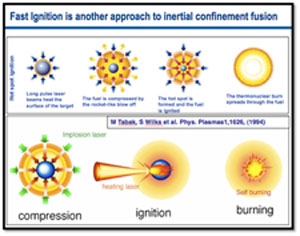Fast ignition inertial confinement fusion
 Controlled Fusion for the generation of pollution-free energy has been a goal of physicists since the mid 1950’s. Fusion of isotopes of the hydrogen ion (protons, deuterons and tritons) is a mechanism that powers stars: It can occur only in extraordinary conditions not naturally found on earth. Although scientists have learned how to exploit this fundamental power source for weapons (thermo-nuclear “hydrogen” bombs), we have had 6 decades of expensive frustration trying to harness this power for a source of useful energy. Currently the US officially supports only one form of research on controlled fusion, that is magnetically confined fusion as expressed in ITER (Latin for “the way”), the international project located in southern France designed to demonstrate fusion energy based on the “Tokomak” concept. Not so officially, there is also a large and robust research effort to demonstrate Inertial Confinement Fusion (ICF) as expressed in the National Ignition Facility (NIF), located on the campus of the Lawrence Livermore National Laboratory in California. This process compresses an exquisitely finely crafted pellet of deuterium-tritium ice to a density exceeding 300 times that of water. The NIF has 192 laser beams focused on a pellet whose dimensions are measured in mm; each of the beams has approximately 5 kJ of energy in a pulse of several nanoseconds. If everything goes as planned, the center of the pellet will rise to temperatures on the order of 50 million degrees and a self-sustaining nuclear reaction will occur where the deuterium and tritium ions fuse together, creating a helium nucleus and releasing an energetic neutron. Predictions for the NIF suggest that the energy output of this “ignition” event will be as much as 20 times that of the laser energy input: that is, over 20 million Joules.
Controlled Fusion for the generation of pollution-free energy has been a goal of physicists since the mid 1950’s. Fusion of isotopes of the hydrogen ion (protons, deuterons and tritons) is a mechanism that powers stars: It can occur only in extraordinary conditions not naturally found on earth. Although scientists have learned how to exploit this fundamental power source for weapons (thermo-nuclear “hydrogen” bombs), we have had 6 decades of expensive frustration trying to harness this power for a source of useful energy. Currently the US officially supports only one form of research on controlled fusion, that is magnetically confined fusion as expressed in ITER (Latin for “the way”), the international project located in southern France designed to demonstrate fusion energy based on the “Tokomak” concept. Not so officially, there is also a large and robust research effort to demonstrate Inertial Confinement Fusion (ICF) as expressed in the National Ignition Facility (NIF), located on the campus of the Lawrence Livermore National Laboratory in California. This process compresses an exquisitely finely crafted pellet of deuterium-tritium ice to a density exceeding 300 times that of water. The NIF has 192 laser beams focused on a pellet whose dimensions are measured in mm; each of the beams has approximately 5 kJ of energy in a pulse of several nanoseconds. If everything goes as planned, the center of the pellet will rise to temperatures on the order of 50 million degrees and a self-sustaining nuclear reaction will occur where the deuterium and tritium ions fuse together, creating a helium nucleus and releasing an energetic neutron. Predictions for the NIF suggest that the energy output of this “ignition” event will be as much as 20 times that of the laser energy input: that is, over 20 million Joules.
As significant as this eagerly anticipated result will be, it is still an enormous step to actually design a power plant based on ICF. This is where the Fast Fusion concept comes in: in Fast Fusion the “trigger” for the fusion within the compressed pellet is the arrival of an ultra-intense laser pulse of nominally 50 kJ energy, with a pulse length of 20 picoseconds. There are many notional advantages in the fast fusion concept: The pellet no longer has to be so precisely manufactured, the energy of the compression lasers can be reduced up to an order of magnitude, and the concept lends itself to the relatively rapid sequencing required for an energy source.
